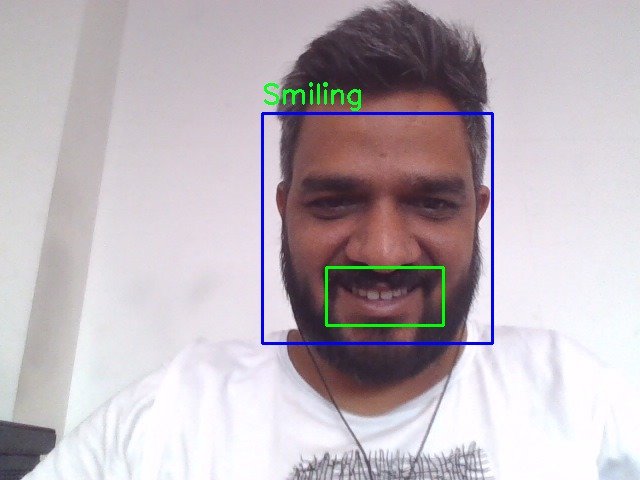Creating a simple camera app for a laptop using Python can be done with the help of the opencv-python library (also known as cv2). This library allows you to capture video from your webcam and display it in a window.
To add face recognition and smile detection functionality to the camera app, you can use OpenCV’s pre-trained Haar Cascades for face and smile detection. Here is an enhanced version of the camera app that includes these features:
- Install the required libraries: Ensure you have
opencv-pythonandnumpyinstalled:
pip install opencv-python
pip install opencv-python numpy
Enhanced camera app code with face and smile detection:
import cv2
import numpy as np
import datetime
# Load pre-trained Haar Cascades for face and smile detection
face_cascade = cv2.CascadeClassifier(cv2.data.haarcascades + 'haarcascade_frontalface_default.xml')
smile_cascade = cv2.CascadeClassifier(cv2.data.haarcascades + 'haarcascade_smile.xml')
def detect_and_display(frame):
gray = cv2.cvtColor(frame, cv2.COLOR_BGR2GRAY)
faces = face_cascade.detectMultiScale(gray, 1.3, 5)
for (x, y, w, h) in faces:
cv2.rectangle(frame, (x, y), (x + w, y + h), (255, 0, 0), 2)
roi_gray = gray[y:y + h, x:x + w]
roi_color = frame[y:y + h, x:x + w]
smiles = smile_cascade.detectMultiScale(roi_gray, 1.8, 20)
for (sx, sy, sw, sh) in smiles:
cv2.rectangle(roi_color, (sx, sy), (sx + sw, sy + sh), (0, 255, 0), 2)
cv2.putText(frame, 'Smiling', (x, y - 10), cv2.FONT_HERSHEY_SIMPLEX, 0.9, (36, 255, 12), 2)
return frame
def main():
# Initialize the webcam (0 is the default camera)
cap = cv2.VideoCapture(0)
if not cap.isOpened():
print("Error: Could not open webcam.")
return
# Video writer for recording
fourcc = cv2.VideoWriter_fourcc(*'XVID')
out = None
recording = False
while True:
# Capture frame-by-frame
ret, frame = cap.read()
if not ret:
print("Error: Failed to capture image.")
break
# Detect faces and smiles
frame = detect_and_display(frame)
# Display the resulting frame
cv2.imshow('Camera', frame)
# Handle keypresses
key = cv2.waitKey(1) & 0xFF
# Capture photo on 'c' press
if key == ord('c'):
timestamp = datetime.datetime.now().strftime("%Y%m%d_%H%M%S")
filename = f"photo_{timestamp}.png"
cv2.imwrite(filename, frame)
print(f"Photo captured and saved as {filename}")
# Start/Stop video recording on 'r' press
if key == ord('r'):
if not recording:
recording = True
timestamp = datetime.datetime.now().strftime("%Y%m%d_%H%M%S")
out = cv2.VideoWriter(f'video_{timestamp}.avi', fourcc, 20.0, (640, 480))
print("Started recording video")
else:
recording = False
out.release()
print("Stopped recording video")
# Save video frame if recording
if recording:
out.write(frame)
# Press 'q' to exit the camera app
if key == ord('q'):
break
# Release the webcam and close the window
cap.release()
if recording:
out.release()
cv2.destroyAllWindows()
if __name__ == "__main__":
main()
Run the enhanced camera app: Save the code to a file, for example enhanced_camera_app_with_face_smile_detection.py, and run it using Python:
python enhanced_camera_app_with_face_smile_detection.py
Explanation of added functionalities:
- Face Detection: The
detect_and_displayfunction uses the Haar Cascade for face detection. Detected faces are marked with blue rectangles. - Smile Detection: Within each detected face, the function uses the Haar Cascade for smile detection. Detected smiles are marked with green rectangles, and the text “Smiling” is displayed above the face.
- Grayscale Conversion: The frame is converted to grayscale for face and smile detection, as the Haar Cascade classifiers work on grayscale images.
This enhanced camera app detects faces and smiles in real-time and displays the results on the video feed. You can further expand it by adding more features, optimizing performance, or integrating it with other libraries for additional functionalities.



